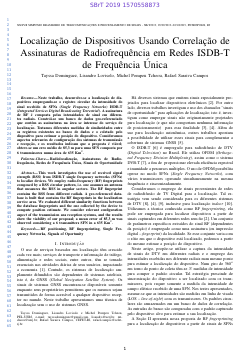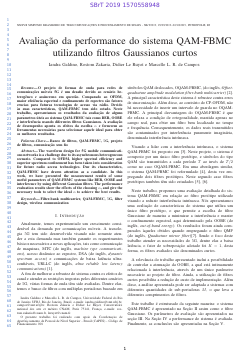
XXXVII Simpósio Brasileiro de Telecomunicações e Processamento de Sinais

Localização de Dispositivos Usando Correlação de Assinaturas de Radiofrequência em Redes ISDB-T de Frequência Única
Tayssa Dominguez, Lisandro Lovisolo, Michel Pompeu Tcheou, Rafael Saraiva Campos
DOI: 10.14209/sbrt.2019.1570558873
Keywords:
Abstract
This work investigates the use of received signal strength(RSS) from ISDB-T single frequency networks(SFNs) to localize devices. We employ radiofrequency(RF) fingerprints composed by a RSS circular pattern, i.e. one assumes an antenna that measures the RSS in angular sectors. The device to be located collects the RF fingerprint which is compared against a database of georeferenced patterns to estimate the device location. The presented approach is evaluated using different functions to compare the collected fingerprints with the ones previously stored in a correlation database(CDB). The results show the feasibility of the proposed strategy, achieving an average error of 85.3 m when using 6 single-frequency transmitters in an area of 635 Km².Download

Decodificação Iterativa em Árvore de Baixa Complexidade para SCMA
Ana L Scharf, Bartolomeu F. Uchôa-Filho, Bruno Fontana da Silva, Didier Le Ruyet
DOI: 10.14209/sbrt.2019.1570558880
Keywords: SCMA Log-MPA Sistema 5G
Abstract
Múltiplo Acesso por Códigos Esparsos (SCMA) é um poderoso candidato para as futuras gerações de comunicações sem fio. Diversos algoritmos de decodificação foram propostos para o SCMA. O conhecido "message-passing algorithm" (MPA) apresenta um bom desempenho, mas com complexidade exponencial. Propomos uma modificação no Log-MPA convencional para reduzir a complexidade da decodificação. Uma estrutura de árvore é associada à equação de decodificação e, evitando-se adequadamente símbolos pouco confiáveis, é obtida uma árvore podada, levando a uma menor complexidade, com um ajuste arbitrário sobre o compromisso entre desempenho e complexidade da detecção conjunta.Download

CASCADE as Correlation Enhancer for CVQKD Protocols
Micael Andrade Souza, Francisco M. Assis, Bruno Barbosa Albert, Leocarlos B S Lima
DOI: 10.14209/sbrt.2019.1570558935
Keywords:
Abstract
We propose a secret key reconciliation approach for CVQKD information reconciliation based on CASCADE protocol, which works as a correlation enhancer, in order to ensure a better utilization of binary quantized sequences from CVQKD protocols. We make a probabilistic analysis of the initial block size in order to control the expected value of the corrected errors in the first step of CASCADE and to bound the amount of information leaked. Our method achieved significant enhancements on binary sequences with BER<0.35 and improved sequences with BER>0.35 to became eligible for information reconciliation.Download

Uma Abordagem Inter-indivíduo para Classificação da Atenção Seletiva Auditiva
Pedro Sergio Torres Figueiredo Silva, Antonio Mauricio Miranda de Sá, José de Seixas
DOI: 10.14209/sbrt.2019.1570558939
Keywords:
Abstract
Uma abordagem inter-indivíduo para classificação da atenção seletiva auditiva através da resposta auditiva de regime permanente é apresentada neste artigo, mostrando novos resultados encontrados pelos autores. Utilizando máquinas de vetor suporte como classificador, foram encontrados resultados similares tanto para taxa de acerto (67,38 % ± 5,38 % ) quanto para taxa de transferência de informação (4,1809 ± 2.6465 bits/min) quando comparados aos valores obtidos anteriormente, embora os novos resultados apresentem melhores valores médios. Assim, é apontada a possibilidade para aperfeiçoamento da metodologia desenvolvida, como previsto no estudo anterior, embora futuros estudos ainda sejam necessáriosDownload

Construção de Códigos Matriciais MDS Utilizando Matrizes de Vandermonde
Débora Beatriz Claro Zanitti, Cintya W. O. Benedito
DOI: 10.14209/sbrt.2019.1570558946
Keywords:
Abstract
Neste trabalho apresentamos uma construção de códigos MDS utilizando matrizes de Vandermonde que são exemplos de matrizes superregulares. Além disso, exemplificamos a codificação e decodificação destes códigos.Download

Avaliação da performance do sistema QAM-FBMC utilizando filtros Gaussianos curtos
Iandra Galdino Andrade, Rostom Zakaria, Didier Le Ruyet, Marcello Campos
DOI: 10.14209/sbrt.2019.1570558948
Keywords:
Abstract
The waveform design for 5G mobile communications networks is a challenge due to its asynchronous heterogeneous scenario. Compared to OFDM, higher spectral efficiency and superior spectrum confinement has been taken into consideration for future radio access technologies. Due its characteristics, QAM-FBMC have drawn attention as a candidate. In this work, we have presented the measurement results of some useful parameters of QAM-FBMC systems like BER, OOBE and interference by using different Gaussian filters. The performance evaluation results show the effects of the choosing alpha, and give the necessary tools to select the ideal alpha to achieve the best results.Download

Virtualização de Redes Ópticas Elásticas: Formulação Linear Considerando o Grooming de Tráfego
Karcius Assis, Marcelo S. Alencar, Raul C. Almeida, Leonardo Mesquita, Thiale Moura
DOI: 10.14209/sbrt.2019.1570558949
Keywords: Planejamento de Redes Ópticas
Abstract
An Elastic Optical Network (EON) can be used as a transport technology for virtualization of optical networks. Two Mixed-Integer Linear Programming (MILP) formulations grooming and non-grooming approaches are proposed in this paper, to design EON networks for different Virtual Optical Networks (VON). The formulations use the concept of modulation format to guarantee efficiency in terms of bandwidth for a physical substrate subject to several virtual topologies. The proposed grooming approach jointly solves the multiple virtual topology design and physical topology design problems. On the other hand, the non-grooming approach solves only the physical topology design. It is shown that the grooming approach can provide good results, since it solves the problem for a complete design when compared to the design without grooming.Download

Combinando Filtro Casado e Topologia para Aprimoramento da Reconstrução de Múons no Calorímetro Hadrônico do ATLAS
Dayane Oliveira Gonçalves, Amanda Camacho Novaes de Oliveira, José de Seixas, Augusto S Cerqueira, Luciano Andrade
DOI: 10.14209/sbrt.2019.1570558955
Keywords:
Abstract
This work presents the study of event discrimination techniques for particles in the ATLAS experiment. The Gaussian energy estimator for maximum likelihood (MLEG) was applied in this project's context and compared with the technique currently used in the calorimeter, the Optimum Filter (OF2). Different topologies for fusion of the information of interest were also evaluated. The results acquired using experimental data showed that the MLEG estimator, for the case in which it is considered only the highest value estimated among four selected information, presents the maximum discrimination efficiency of the events of interest, being therefore the method best suited for the task.Download

Adaptive linear predictors in cascade for blind deconvolution of non-stationary and non-minimum-phase channels
Renan Brotto, Kenji Nose Filho, Romis Ribeiro Attux, João Romano
DOI: 10.14209/sbrt.2019.1570558960
Keywords:
Abstract
Linear prediction plays a fundamental role in digital signal processing due to its interesting theoretical and practical aspects. An important application is the problem of predictive blind deconvolution. However, it is well known that the classical predictive technique, which assumes the use of the mean squared error (MSE) criterion together with a linear FIR (finite impulse response) fails when the distortion system is non-minimum-phase. In previous works, we have investigated alternative criteria for blind predictive deconvolution, replacing the MSE, which is related to the L2 norm, by the generalized Lp norm, with p different of 2. The results were effective for some non-minimum-phase systems, but not all of them, which clearly indicated a limitation of the linear FIR structure. In the present paper, we propose to employ a cascade of forward and backward linear predictors. The approach is applied to the blind equalization of communication channels. Due to the characteristics of the transmitted signals, the Lp criterion must be considered with p tending to infnity. We opt to use p=4, which corresponds to the MFE (Mean Fourth Error) criterion, as a smooth approximation of the LInf norm. Also, it allows applying the LMF (Least Mean Fourth) adaptive algorithm, in order to track non-stationary behaviors. Simulation results show that the proposed solution is able to deal effectively with the blind equalization of non-stationary and non-minimum-phase channels.Download

Reconhecimento de Emoções em Sinais de Fala Usando Transferência de Aprendizado
Sergio Gomes Junior, Flávio Ávila, Michel Pompeu Tcheou
DOI: 10.14209/sbrt.2019.1570558970
Keywords:
Abstract
Neste artigo, propõe-se um sistema de reconhecimento de emoções em sinais de fala usando redes profundas convolucionais com as técnicas de transferência de aprendizado e aumento de base de dados. A transferência de aprendizado foi realizada a partir de uma rede residual (Resnet) de 34 camadas treinada para a base ImageNet. O aumento da base foi realizada alterando-se o pitch e alargando-se no tempo as amostras de sinais de fala das classes de felicidade, tristeza, raiva e neutra da base IEMOCAP (Interactive Emotional Dyadic Motion Capture). O sistema proposto foi capaz de classificar corretamente 81,26% das amostras.Download